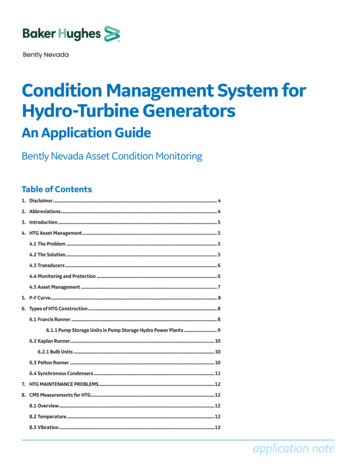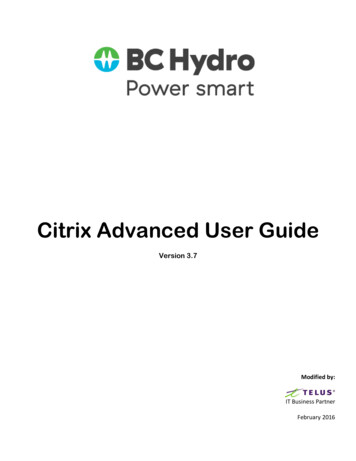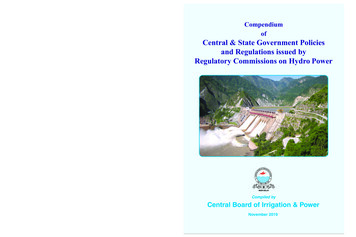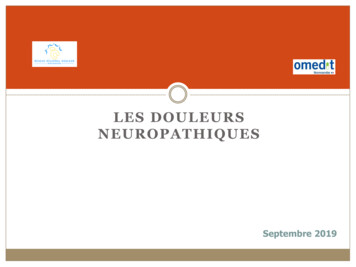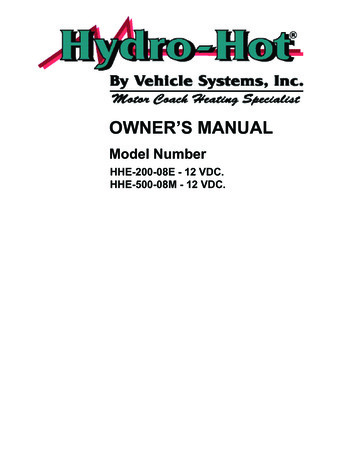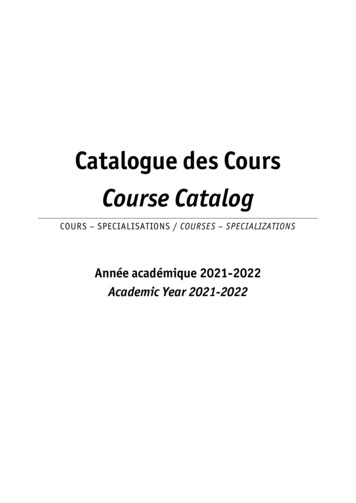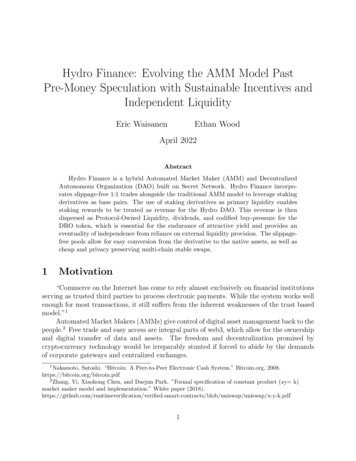
Transcription
Hydro Finance: Evolving the AMM Model PastPre-Money Speculation with Sustainable Incentives andIndependent LiquidityEric WaisanenEthan WoodApril 2022AbstractHydro Finance is a hybrid Automated Market Maker (AMM) and DecentralizedAutonomous Organization (DAO) built on Secret Network. Hydro Finance incorporates slippage-free 1:1 trades alongside the traditional AMM model to leverage stakingderivatives as base pairs. The use of staking derivatives as primary liquidity enablesstaking rewards to be treated as revenue for the Hydro DAO. This revenue is thendispersed as Protocol-Owned Liquidity, dividends, and codified buy-pressure for theDRO token, which is essential for the endurance of attractive yield and provides aneventuality of independence from reliance on external liquidity provision. The slippagefree pools allow for easy conversion from the derivative to the native assets, as well ascheap and privacy preserving multi-chain stable swaps.1Motivation“Commerce on the Internet has come to rely almost exclusively on financial institutionsserving as trusted third parties to process electronic payments. While the system works wellenough for most transactions, it still suffers from the inherent weaknesses of the trust basedmodel.”1Automated Market Makers (AMMs) give control of digital asset management back to thepeople.2 Free trade and easy access are integral parts of web3, which allow for the ownershipand digital transfer of data and assets. The freedom and decentralization promised bycryptocurrency technology would be irreparably stunted if forced to abide by the demandsof corporate gateways and centralized exchanges.1Nakamoto, Satoshi. “Bitcoin: A Peer-to-Peer Electronic Cash System.” Bitcoin.org, 2008.https://bitcoin.org/bitcoin.pdf2Zhang, Yi, Xiaohong Chen, and Daejun Park. ”Formal specification of constant product (xy k)market maker model and implementation.” White paper f1
Up until this point, AMMs have relied solely upon speculation to derive their value.They offer an integral service but don’t adequately capture the value they provide throughtheir token. The valuations for AMM governance tokens are arbitrarily based on Total ValueLocked (TVL) and volume, but rarely do the tokens offer substantially more than governancepower and theoretical value based on potential fees extracted from the very users themselves.High valuations are required to sustain the high Annual Percentage Rates (APR) which areneeded in order to retain liquidity providers, the mercenary capital on which they depend.In the case of a black swan event, these protocols will almost certainly be damaged beyondrepair, unable to provide strong enough incentives to retain or incentivize user capital. Thecurrent models simply do not provide a transition from pre-revenue speculation to postmoney sustainability.3In 2019, Gartner positioned blockchain technology in the ‘trough of disillusionment’category in their well-respected Hype Cycle for Emerging Technologies. This is a clear indicator of decreased investor interest as experiments and implementations fail to deliver. Thesefailed experiments were stepping stones towards an eventuality promised by DecentralizedFinance (DeFi).We are witnessing many developments in blockchain technology that will changethe current pattern. By 2023, blockchain platforms will be scalable, interoperable, and will support smart contract portability and cross chain functionality.They will also support trusted private transactions with the data confidentialityrequired. All together, these technology advances will take us much closer tomainstream blockchain and the decentralized web, also known as Web 3.0 4In 2021, Avivah Litan, distinguished analyst and research vice president at Gartnerstated, “Decentralized finance (DeFi) applications offer substantially greater financial rewards than traditional finance. Centralized firms like hedge funds already take advantageof this.” and went on to elaborate, “We project that by 2023, 35% of enterprise blockchainapplications will integrate with decentralized applications and services. The rewards aresimply too high to ignore, and are far greater than the costs.”5With enterprises already aware and starting to take advantage of the promises of decentralized finance, it is more crucial than ever to provide sustainable, interoperable, highyield, low risk options that protect the privacy of users while not losing sight of regulatorycompliance.3Callow, Dana A, and Michael Larsen. “Understanding Valuation: A Venture Investor’s Perspective.”Millennia Partners. Boston Millennia Partners, 2003.http://www.millenniapartners.com/ tner, Meghan, and Laurence Gartner. “Gartner 2019 Hype Cycle Shows Most BlockchainTechnologies Are Still Five to 10 Years Away from Transformational Impact.” Gartner Newsroom PressReleases. Gartner Inc, October 8, s-away-from-transformational-impact5Litan, Avivah. “Hype Cycle for Blockchain 2021; More Action than Hype.” Gartner Blog. Gartner Inc,July 14, 2021. e/2
2Hydro FinanceHydro Finance is a novel adaptation of previous AMM models aligned to create sustainable token economics and designed to generate and capture continual value. Hydro is builton Secret Network, a privacy preserving smart contract platform built on Cosmos SDK.6SCRT (the native governance token of Secret Network) and most other tokens in the Cosmos ecosystem run on a Delegated Proof of Stake (DPoS) inflationary model. By utilizingthe SNIP-20 standard to create these staking derivative solutions for various supported inflationary tokens, the liquidity provided on Hydro.Finance exists in tokenized representationsof staked assets that are earning interest and securing the various Layer-1 networks in theCosmos ecosystem.7 By capturing that interest directly, the DAO will generate steady revenue from the liquidity that is hosted, which will in turn be deployed as Protocol-OwnedLiquidity (or POL), dispersed to DRO stakers, and used to purchase the DRO token. POLand dividends create measurable value for the DRO token, which is given as rewards toliquidity providers. Increased value of the DRO token should incentivize mercenary capitalto provide liquidity, which will again increase the revenue. As more POL is generated, webecome less dependent on said mercenary capital until it is no longer necessary entirely andthe protocol has achieved complete sustainability.By being invested in the supported assets it aims to serve, the DRO DAO will be moreconnected to its user-base, and further incentivized to facilitate the success of those assetsand the entire Cosmos ecosystem. In addition to economic sustainability, use of stakingderivatives allows the Hydro DAO to have governance power in the Layer-1 networks itsupports, providing a vector for privacy preserving voting in the governance of all Layer-1chains supported through the DAO.The core principles of Hydro Finance are: Create a Catalyst for Liquidity on Secret Network Facilitate the Growth of the Cosmos Ecosystem Protect User Privacy & Security Ensure Regulatory Compliance Create Sustainable Value Capture Value Sustainably6Kwon, Jae, and Ethan Buchman. “Cosmos Whitepaper: A Network of Distributed Ledgers.” CosmosNetwork. Tendermint Inc., January 30, 2019. ami, Assaf, Reuven Podmazo, and Itzik Grossman. “Secretfoundation/Snips: Secret NetworkImprovement Proposals (SNIPs) .” GitHub. Secret Foundation, September 2020.https://github.com/secretfoundation/snips3
3Hydro PoolsHydro will have two types of AMM pools: Hydro and Oxy. Hydro pools will offer thetypical x*y k market maker mechanism.8 Pairs on Hydro pools will be SNIP-20s based onLayer-1 staking derivatives, Layer-2 tokens built on Secret Network, and bridged assets fromexternal ecosystems. All of the fees (0.20% of trade volume) from the Hydro pools go tobuyback and burn the DRO token.4Oxy PoolsOxy pools offer consistent swaps at a 1:1 ratio between 2 assets with scaling feesinstead of slippage. Having exponential fees prevents any one side of the pool from beingfully depleted while enabling cheaper and easier conversions that utilize more of the liquiditythan the x*y k model allows. All fees collected in the Oxy pools, both from trades andwithdrawals, will remain in the Oxy pools as Protocol-Owned Liquidity.The formula for the trade fees is calculated as: T 0.03% 0.025% S !3N 1EwhereT is the Oxy trade feeS is the ending pool percent of sold tokenE is the ending pool percent of other tokensN is the number of different tokens in the Oxy PoolExample: Alice wants to trade 100 shSCRT for SCRT. The SCRT Oxy Pool has 10,000SCRT and 5,000 shSCRT.S 5, 100E 9, 900 5100 2 19900T 0.03% 0.025% N 2!3 0.033%0.033% 100 SCRT 0.033 SCRT in fees8Pourpouneh, Mohsen, Kurt Nielsen, and Omri Ross. “Automated Market Makers.” IFRO WorkingPaper, No. 2020/08. University of Copenhagen, Department of Food and Resource Economics (IFRO),Copenhagen, July 2020. FRO WP 2020 08.pdf4
A template for example fees in a 2-token pool for balancing and unbalancing the poolsis as follows:Pool 00%In order for the Oxy pools to be sustainable they must avoid depletion and remain relatively balanced as often as possible. One added balancing incentive is HYDR8, a primitivewhich pays traders in accordance with their trading volume. The combination of addingHYDR8 and keeping fees incredibly low for balancing the pools creates unique profit opportunities and permanently incentivizes the balancing of these pools. If the user base failsto balance these pools sufficiently, this process could be automated indefinitely through thedeployment of simple arbitrage bots. Bad actors could theoretically slow down a pool ormake it temporarily out of balance, but it would be expensive for them to do so, making iteconomically inviable. Additionally, the price they’d pay in fees would remain in the pool asPOL, which is revenue for the DAO and replenishes the very liquidity the bad actor wouldbe trying to deplete.In addition to the trade fees, two conditional withdrawal fees must exist. Liquidityprovision in the Oxy pools is single-sided but grants providers partial ownership of thewhole liquidity, not any specific side. In order to prevent users from depositing liquidity andwithdrawing on another side as a means of avoiding the trade fee, there will be a 10-daysoft-lockup period. Unbonding liquidity can be done in any side of the pool, but removingit will have a fee of:max( 0 , 1% 0.1% D )whereD is the number of daysThis means that users can have access to their funds immediately, if necessary, or canwait 10 days to withdraw their funds for free. It also means that users can perform fee-lessswaps through these pools by depositing and withdrawing liquidity, but they would take 10days to perform.5
The other conditional withdrawal fee is exponential and meant to protect the pool fromdepletion in the same manner as the scaling trade fees. The formula is as follows:C 0.023% T !3N 1 C 0.25%WwhereC is the conditional unbalancing feeT is the ending pool percent of other tokensN is the number of different tokens in the Oxy PoolW is the ending pool percent of withdrawn tokenExample: Alice wants to emergency withdraw 10k USDC from the Oxy Stable Pool.The pool is broken down as 0007,000,0006,000,0004,000,000The Conditional Unbalancing Fee is calculated first:W 1, 990, 000 0.0865622, 990, 000T 21, 000, 000 0.9134422, 990, 000N 5C 0.023% 0.91344 !35 1 C 0.25%0.086560.4223% 0.25% TRUE0.4223% 10, 000 sUSDC 42.23 sUSDC in fees6
Emergency Withdrawal means D 0:1% 0.1% D 1%The Emergency Withdrawal Fee will then only be in relation to the remaining 99.5777%of the original requested withdrawal.Emergency Withdrawal 9, 957.77 sUSDC 1% 99.58 sUSDCThe combined Withdrawal fee for this example would be:42.23 sUSDC 99.58 sUSDC 141.81 sUSDC, or 1.4181%A template for conditional unbalancing fees for a 2-token pool is as follows:Pool se fees allow users to pull out funds whenever they want, in whatever denominationthey prefer, but disincentivizes harm to the protocol. No user must experience withdrawalfees if they wait 10 days and withdraw the tokens in accordance with the needs of the pool.100% of fees in Oxy pools will remain in the pool as POL.5HYDR8: Volume IncentivizationHYDR8 is a reward token given to traders in correlation with their trading volume.Designed as a subsidy to lessen the burden of trade fees and reward traders in additionto liquidity providers with DRO’s inflation, HYDR8 plays an integral part in ensuring thelongevity of the Oxy pools. Balancing the Oxy pools has trade fees as low as 0.03%, whichwill be lower than the HYDR8 rewards, making trading that directly benefits the usabilityand sustainability of those pools profitable for the users.The HYDR8 contract will receive adjustable DRO allocation directly from inflation.HYDR8 tokens will be minted upon each trade and are always redeemable for their proportion of total DRO held in the HYDR8 contract. The HYDR8 is burned (removed from totalsupply) upon DRO redemption.7
The HYDR8 Claim ratio is as follows:HYDR8 Accumulated DRO TokensTotal HYDR8 SupplyTo properly understand the Hydro Finance trade fees as experienced by the user, theHYDR8 Protocol must be factored in.Net Trade Fee Trade Fee HYDR8Let’s revisit Alice’s Oxy Trade where she traded 100 shSCRT for 100 SCRT whichresulted in a trade fee of 0.033%, or 0.033 SCRT.Let us suggest for this example: There are 50,000 DRO currently in the HYDR8 contract There are 10,000,000 HYDR8 in the current total supply HYDR8 is minted at a rate of 1 HYDR8 per 1 of trade volumeAlice’s trade would’ve minted a number of HYDR8 tokens equal to:H 100PwhereH is the HYDR8 mintedP is the price of SCRTIf SCRT is valued at 20, then Alice’s trade had a volume of 2,000, her trade feewas 0.66, and 2,000 HYDR8 will be minted and given to her. The updated total supplyof HYDR8 after this trade is 10,002,000, but the number of DRO in the contract hasn’tchanged (though in reality it’s added to every block). If Alice redeems her DRO at thistime, she’ll receive:2, 000 50, 000 9.998 DRO10, 002, 000The HYDR8 traded in will be burned from the supply, lowering the supply back to10,000,000 HYDR8. The available DRO in the contract will lower from 50,000 to 49,990.002.Whether or not Alice fully recuperated her trade fees is dependent on the price of DRO.8
In order to properly incentivize balancing the pools, it’s imperative that HYDR8 maintains a redemption level above 0.03% of trade volume. Should it be above 0.06% of tradevolume, it can be gamed by wash trading across balanced Oxy pools until it is lowered toapproximately 0.06%. While we do not control the price of the DRO token, nor the volumetraded, the weight of the percentage of inflation directed towards the HYDR8 contractedcan be adjusted if need-be to ensure the success and longevity of the protocol.Assuming 0.06% of trade volume is recuperated by HYDR8, in Alice’s trade DRO wouldhave a price of 0.12, and she would’ve received 1.20 worth of DRO when she redeemed herHYDR8. Her net trade fee would be:Net Trade Fee 0.66 1.20 0.54The negative trade fee means that Alice profited from her 1:1 slippage-free trade. Asillustrated in the example Oxy and Hydro will both offer lower net trading fees than currentmarket standards.By incorporating external revenue and generating Protocol-Owned Liquidity, we arenot dependent upon trade fees for long-term liquidity provider retention and can sustainablycapture the value from the fees directly. Through the use of HYDR8, the protocol willcapture more from user fees than the users themselves will ever experience, and the Oxypools can indefinitely be profitably balanced.9
6Secret Hydro Derivatives: External Revenue & FrontRunning ResistanceSecret Hydro Derivatives are SNIP-20 representations of staked assets on the varioussupported Cosmos Layer-1 blockchains. These tokens can only be minted by sending the L-1tokens (such as ATOM, LUNA, and SCRT) to the Hydro address on that network. Thesetokens are then staked, securing the network, and earning staking rewards from inflationand network fees for the Hydro DAO. Rewards will be collected regularly and sent to bulkdistributors. The Bulk Distributors will deploy the rewards as follows:The Protocol-Owned Liquidity will be deployed to the native asset side of the Oxy pool.This will allow for sustainable liquidity by which to liquidate the Secret Hydro Derivativeswithout needing to wait through an unbonding period.10
The Farm is a contract which distributes rewards to DRO stakers. Each supportedSecret Hydro Derivative will have an accompanying farm in which users can stake theirDRO to earn the corresponding Layer-1 token.The Buyback/Burn provides sustainable and measurable codified buy-pressure for theDRO token. The price of DRO directly correlates to the APRs offered to liquidity providers.Revenue is derived from the liquidity provided. Therefore, direct buy-side pressure for DROincentivizes mercenary capital to contribute to liquidity provision in the short-term, whichgenerates revenue that will be used to sustain Hydro Finance in the long term.The Secret Hydro Derivatives are SNIP-20 tokens which inherit all of the privacy preserving qualities provided by the nature of smart contracts on Secret Network. Hydro Financeis also front-running resistant. Front-running is a primary method of miner extractable value,which is expanded upon by the Bank for International Settlements:Certain features of AMMs expose liquidity-takers to market manipulation onDEXs. The execution of trades in AMMs requires validations based on theblockchain’s consensus protocol, i.e. buy and sell orders are stored in a publicmemory pool, so that validators (also known as “miners”) can add them to theblockchain. When submitting orders, liquidity-takers are uncertain about thetiming of their orders’ execution and the execution prices, as these depend on theexecution sequence. Importantly, the order quantities become public knowledgebefore their price impact has materialized – which is easily predictable from thebonding curve. This time lag opens the door to malicious activity, whereby atrader may try to place a buy and an offsetting sell order immediately before and11
after, respectively, the pre-announced buy order. When the latter order is largeenough, the bonding curve implies that the malicious trader’s sell order will beexecuted at a higher price than his buy order, thus generating a profit. Suchfront-running behavior is particularly attractive to large validators because theyhave a higher chance to “win” the next block and time their front-running tradesoptimally. The profits sometimes are called “miner extractable value”.9Since actions that take place inside a Secret contract aren’t viewable and remain encrypted within the mempool, the actions transpiring in a trade aren’t knowable, and thereforecan’t be front run. Furthermore, this means that users can trade directly from non-SNIP-20assets to other non-SNIP-20 assets directly on Hydro Finance, while being protected fromfront-running! When trading two non-SNIP tokens directly, such as SCRT for ATOM, therouting would be:SCRT shSCRT shAT OM AT OMHere, the first and last pools are Oxy pools, and the middle is a Hydro pool. The useris making a 3-jump trade, directly interacting only with the non-SNIP assets. However, theygain security through the utility of the Secret Hydro Derivatives while paying only 0.31%(on average) in fees and earning much if not most of that back through HYDR8.7DRO DAO: Money & Power in the CosmosDRO will serve as the governance token for the Hydro Finance DAO. The DAO’s governance system uniquely leverages the privacy preserving nature of Secret Network’s smartcontracts in a way that allows for provably accurate voting, in which each user’s vote isprivate. Stakers in the ‘Infinity Pool’ (the farm that earns more DRO and other voluntarilycontributed tokens from listing partners) get to participate in this governance. Users have7-days to cast their vote and votes are tallied in accordance with the amount of DRO tokensstaked at the end of the 7-day period.Secret Hydro Derivatives create the opportunity for the Hydro DAO to own governancepower in the various Cosmos Layer-1 tokens that are supported. There will be subsectionsof the Hydro governance model that allow DRO stakers to utilize the private voting featureto direct the DAO’s vote on the various native chains. These votes will have a shorter timeperiod.9Aramonte, Sirio, Wenqian Huang, and Andreas Schrimpf. “Trading in the DEFI Era: AutomatedMarket- Maker.” The Bank for International Settlements, December 6, 2021.https://www.bis.org/publ/qtrpdf/r qt2112v.htm12
There are 3 types of proposals that can be governed by the DAO:1. Spend Proposals(a) The DAO owns all Protocol-Owned Liquidity and can spend it to fund variousinitiatives according to the will of the community.(b) The DAO can also add its POL to Hydro Pools via governance.i. 1 Million worth of shSCRT and 1Million worth of shATOM can be addedto the shSCRT shATOM Hydro Pool to raise liquidity in said pool by 2Million, while potentially further balancing the Oxy Pools for said tokens.2. Layer-1 Proposals(a) All on-chain proposals on the native chains we support will be voted on by theDRO DAO.(b) If a quorum isn’t reached, the Hydro DAO will vote to abstain from the proposal.(c) The Hydro DAO will not create proposals on any of the supported chains.3. Signaling Proposals(a) The DAO can use signaling proposals to better gauge sentiment on parameterchanges, or to suggest actions desired of the core teami. Lower inflationii. Change percentages of the bulk distributorsiii. Change weights of the DRO rewards(b) The core teams (High Vault & SCRT Labs) will take signaling proposals intostrong consideration but reserve the right to act as they see fit in order to bestensure durational success for Hydro Finance.13
8DRO Viewing Key Manager (VKM)Secret Network utilizes “private contracts”, a term originally coined in the Enigmawhitepaper.10 Since smart contracts on Secret Network are private by default, access to seeyour own assets and interactions must be manually added. “Queries in Cosmos are unable tocryptographically authenticate the querier’s identity; Secret Network solves this by allowingcontracts to have an encrypted viewing key that is used to validate the identity of the caller.This viewing key allows for decryption of a range of associated data for any given address.”11A viewing key is required to even obtain basic balances. While this is much more secure thanthe public practices on other smart contract platforms, this proves confusing and difficultfor users. To best leverage the security of private user data while providing a more seamlessuser experience, Hydro will use a custom-built ‘DRO Viewing Key Manager’.The DRO Viewing Key Manager (VKM) is a contract that designates multiple contracts to query one viewing key. Instead of every token and contract on Hydro having anindividual viewing key to be exported, users will only need to create one viewing key thatwill immediately grant the user the ability to view and use all contracts created by Hydro.This includes the DRO token, LP tokens, Secret Hydro Derivative tokens, HYDR8, applications and games built on Hydro, earn contracts, and more. What this does not include ispre-existing tokens, and tokens that are created independently of Hydro, such as other L2’son Secret Network, or tokens like sXMR or sUST, whose contracts Hydro Finance did notcreate.While simplifying the viewing key process is easier on the user and far less computationally demanding than using permits (a viewing key alternative for newer contracts), it comeswith the risk of having to over-share data to maintain regulatory compliance. To betterprotect users’ data, the DRO VKM has been developed to be capable of creating secondaryviewing keys, which would only share the data of individual contracts. This allows usersthe freedom to share limited data, while enjoying the ease-of-use of not having to constantlyworry about viewing keys. This computational conservation of the contracts in comparisonto permits allows for lower gas prices, less stress on the blockchain, and faster executiontimes.An additional feature of the DRO VKM are catalogs of users’ interactions. Decipheringone’s own data while trading and liquidity providing on a privacy-centric platform is far fromtrivial. To address this, detailed logs that are available only to the user themselves allow fora combination of security, utility, and compliance. These logs, which are cryptographicallysecured by the viewing key, are then able to be rendered in a clear, readily available, conciseuser interface that will allow tax information to be exported in the users’ desired format.10Zyskind, Guy, Oz Nathan, and Alex ’Sandy’ Pentland. “Enigma: Decentralized Computation Platformwith Guaranteed Privacy” M.I.T. Living Lab. Massachusetts Institute of Technology, December 016/01/enigma full.pdf11Woetzel, Carter. “Secret Network: A Privacy-Preserving Secret Contract & Decentralized ApplicationPlatform.” Secure Secrets. scrt.network, January 2021.https://www.securesecrets.org/Secret Network Graypaper 2.0.1 1.pdf14
9Liquidity IndependenceBy building a treasury of Protocol-Owned Liquidity, there will eventually be a thresholdat which the protocol is no longer dependent upon mercenary capital. If a signaling proposalis passed that reduces inflation to 0, and the core team agrees that this is best for theprotocol, inflation can be fully redirected to the burn address. When this time comes, thederivatives from the substantial treasury of liquidity owned by the DRO DAO will still beearning revenue. This means that liquidity will continue to grow and be placed in accordancewith DAO Governance. DRO stakers will also still earn dividends from supported assets andthere will still be consistent buy-pressure for the now deflationary DRO token.Previous AMM’s have never decoupled from external liquidity provision, as any protocolowned liquidity has needed to come from largely unsustainable bond models or fee extraction.12 This particular eventuality for a currently inflationary token provides a successfulmodel for decoupling, includes sustainable growth, and removes the forced timeline thatacts as an expiration date by which a product must reach independence. By creating asynergy between inflationary and deflationary pressure with consistent treasury growth andthe promise of future independent functionality, Hydro is as flexible as it is profitable, withlong-term sustainability at its core.12Capponi, Agostino, and Ruizhe Jia. “The Adoption of Blockchain-Based Decentralized Exchanges.”arxiv.org. arxiv, July 22, 2021. https://arxiv.org/pdf/2103.08842v115
ReferencesAramonte, Sirio, Wenqian Huang, and Andreas Schrimpf. “Trading in the DEFI Era:Automated Market-Maker.” The Bank for International Settlements, December 6, 2021.https://www.bis.org/publ/qtrpdf/r qt2112v.htmCallow, Dana A, and Michael Larsen. “Understanding Valuation: A Venture Investor’sPerspective.” Millennia Partners. Boston Millennia Partners, 2003.http://www.millenniapartners.com/ oni, Agostino, and Ruizhe Jia. “The Adoption of Blockchain-Based DecentralizedExchanges.” arxiv.org. arxiv, July 22, 2021. https://arxiv.org/pdf/2103.08842v1Gartner, Meghan, and Laurence Gartner. “Gartner 2019 Hype Cycle Shows MostBlockchain Technologies Are Still Five to 10 Years Away from TransformationalImpact.” Gartner Newsroom Press Releases. Gartner Inc, October 8, s-away-fromtransformational-impactKwon, Jae, and Ethan Buchman. “Cosmos Whitepaper: A Network of DistributedLedgers.” Cosmos Network. Tendermint Inc., January 30, rLitan, Avivah. “Hype Cycle for Blockchain 2021; More Action than Hype.” Gartner Blog.Gartner Inc, July 14, 2021. e/Morami, Assaf, Reuven Podmazo, and Itzik Grossman. “Secretfoundation/Snips: SecretNetwork Improvement Proposals (SNIPs) .” GitHub. Secret Foundation, September2020. https://github.com/secretfoundation/snipsNakamoto, Satoshi. “Bitcoin: A Peer-to-Peer Electronic Cash System.” Bitcoin.org, 2008.https://bitcoin.org/bitcoin.pdfPourpouneh, Mohsen, Kurt Nielsen, and Omri Ross. “Automated Market Makers.” IFROWorking Paper, No. 2020/08. University of Copenhagen, Department of Food andResource Economics (IFRO), Copenhagen, July 4/1/IFRO WP 2020 08.pdfWoetzel, Carter. “Secret Network: A Privacy-Preserving Secret Contract
3 Hydro Pools Hydro will have two types of AMM pools: Hydro and Oxy. Hydro pools will offer the typical x*y k market maker mechanism.8 Pairs on Hydro pools will be SNIP-20s based on Layer-1 staking derivatives, Layer-2 tokens built on Secret Network, and bridged assets from



